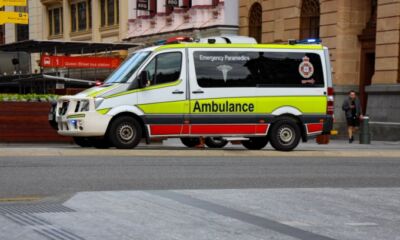Ambulance cover in Queensland
If you have an emergency in Queensland that requires ambulance services, do you need to pay for the trip? We take a look at how ambulance cover in Queensland works.

If you have an emergency in Queensland that requires ambulance services, do you need to pay for the trip? We take a look at how ambulance cover in Queensland works.
Ambulances provide essential services across Australia, assisting and transporting those in need to hospital or other healthcare centres. In many parts of Australia, the patient is required to pay for those services, either out of their own pockets or via taking out a private health insurance policy that includes ambulance cover, but the rules can vary between different states and territories.
If you are in Australia and need an ambulance, call Triple Zero (000).
Are ambulances free in Queensland?
Whether or not you have to pay for ambulance services in Queensland depends on whether you are a resident of the state, the Queensland Ambulance Service (QAS) states:
- If you are a permanent resident of Queensland: Ambulance transport and services are free.
- If you are not a permanent resident of Queensland: You may have to pay for ambulance services in Queensland, although some exemptions do apply.
Access to ambulance services for QLD residents
If you or one of your dependents requires ambulance assistance and/or transport within the state of Queensland, that service will be provided for free if at least one of you is a Queensland resident. This is because the Queensland Ambulance Service (QAS) is fully funded by the Queensland Government. Their services include transport to both private and public hospitals, such as after an emergency, as well as transport from one hospital to another and other medically authorised transport.
Does Queensland ambulance cover interstate services?
The Queensland Government explains that if you or one of your dependants receives ambulance assistance or transport outside of Queensland, you will receive an invoice for these services which you can then forward to the QAS for payment. In doing so, you may need to provide proof that you are a Queensland resident, for example, by supplying a current copy of your driver’s licence or a recent bank statement showing your address.
Dependents are classified as “individuals who are under 25 years of age and a full-time student at an education institution”, according to the QLD Government. This could mean, for example, an under 25 university student studying interstate but whose parent(s) or guardian permanently resides in Queensland. Proof may be required, such as a current Medicare card, birth certificate or student ID card.
Are visitors to Qld covered for ambulance services?
Non-Queensland residents are typically not eligible for free ambulance services within Queensland, and may be responsible for paying the costs of any service provided to them. Domestic travel insurance also may not cover all emergency medical transport costs. This is where health insurance with ambulance cover may help. There are a handful of exceptions as outlined by the Queensland Government:
- You’re aged under 25 and are a full-time student at a Queensland educational institution
- You’re aged under 25, are a full-time student at an interstate educational institution and a child of a person whose principal place of residence is in Queensland
- You hold an eligible Department of Veterans’ Affairs (DVA) card
- You are covered by a claim under the Workers’ Compensation and Rehabilitation Act 2003 or Motors Accident Insurance Fund.
Requests for exemptions can be made to QAS.
Queensland ambulance cover for residents of other states and territories
ACT residents
ACT residents who are covered for interstate ambulance services through their private health insurer will be able to forward an invoice for ambulance services provided by QAS to their health fund.
New South Wales residents
NSW residents may be eligible to have any ambulance assistance received in Queensland paid for if:
- They hold a NSW pensioner or healthcare card, in which case the NSW Ambulance Service may pay their invoice
- They are covered for ambulance services through their private health insurer. They would need to forward the invoice to their health insurer for processing and payment.
Northern Territory residents
Northern Territory residents may be eligible to have any ambulance services received paid for if they:
- Are a St John Ambulance NT member, whose membership was valid at the time of receiving the ambulance services
- Are covered for interstate ambulance services through a private health insurer. They would need to forward the invoice to their health insurer for processing and payment.
South Australian residents
South Australian residents may be eligible to have the costs of any ambulance services received paid for if they:
- Are a South Australia Ambulance Service (SAAS) member with interstate ambulance cover, whose membership was valid at the time of receiving the ambulance services
- Are covered for interstate ambulance services through a private health insurer. They would need to forward the invoice to their health insurer for processing and payment.
Tasmanian residents
Tasmanian residents may be eligible to have ambulance services they receive paid for if they are covered for interstate ambulance services through a private health insurer.
The Tasmanian government does cover ambulance services for Tasmanian residents who require them while in their home state, as well as other selected states and territories. Unfortunately, Queensland is not one of those states.
Victorian residents
Victorian residents may be eligible to have any ambulance services received paid for if they:
- Hold a Victorian pensioner or health care card, in which case Ambulance Victoria may pay their invoice
- Are an Victoria Ambulance Service Member, whose membership was valid at the time of receiving the ambulance services. Ambulance Victoria may pay their invoice
- Are covered for interstate ambulance services through a private health insurer. They would need to forward the invoice to their health insurer for processing and payment.
Western Australian residents
Western Australian residents may be eligible to have ambulance services paid for if they:
- Hold a WA aged pensioner card, in which case St John Ambulance Service WA may pay their invoice
- Are an St John Ambulance WA Member, whose membership was valid at the time of receiving the ambulance services. St John Ambulance WA may pay their invoice
- Are covered for interstate ambulance services through a private health insurer. They would need to forward the invoice to their health insurer for processing and payment.
Expats and other international visitors
There are currently no reciprocal arrangements for QAS ambulance services for overseas visitors or Australian expatriates, which means the cost of the services provided would need to be paid in full.
Expats and other international visitors who do not live in Australia are encouraged by the Queensland Government to get in touch with a travel agent to discuss potential options for ambulance cover while spending time in the state.
This may come in the form of a travel insurance policy. When making a medical claim for ambulance services through travel insurance, you will need a receipt of your payment, which should be supplied to you by QAS.
QLD Ambulance cost
If you require the services of an ambulance in Queensland and do not have an exemption like those listed above, this is what you can expect the cost of QLD ambulance services to be at the time of writing:
← Mobile/tablet users, scroll sideways to view full table →
| Ambulance transport type |
Fee per service |
|---|---|
| Emergency transport (Code 1 and Code 2) |
$1,459.09 (flat-fee) |
| Non-emergency transport (Code 3 and Code 4) |
$540.49 (first 50 kilometres) + $2.19 per extra kilometre |
Source: Queensland Government – 07/03/25
If you need treatment supplied by an ambulance, but do not require to go to hospital, you can expect to pay:
← Mobile/tablet users, scroll sideways to view full table →
| Ambulance treatment (no transport to hospital required) |
Cost (the greater of) |
|---|---|
| Minimum fee | $148.19 |
| or kilometres travelled to reach you |
$20.14 per kilometre |
Source: Queensland Government – 07/03/25
The maximum fee that can be charged for this type of treatment is $1,459.09. QAS also provides casualty room consultations (onsite treatment) for $24.91—if no transport to the hospital or patient is required.
 Psychiatric services
Psychiatric services
 Rehabilitation
Rehabilitation
 General dental
General dental
 Physiotherapy
Physiotherapy
 Psychiatric services
Psychiatric services
 Rehabilitation
Rehabilitation
 General dental
General dental
 Physiotherapy
Physiotherapy
 Psychiatric services
Psychiatric services
 Rehabilitation
Rehabilitation
 General dental
General dental
 Physiotherapy
Physiotherapy
 Psychiatric services
Psychiatric services
 Rehabilitation
Rehabilitation
 General dental
General dental
 Physiotherapy
Physiotherapy
 Psychiatric services
Psychiatric services
 Rehabilitation
Rehabilitation
 General dental
General dental
 Physiotherapy
Physiotherapy
 Psychiatric services
Psychiatric services
 Rehabilitation
Rehabilitation
 General dental
General dental
 Physiotherapy
Physiotherapy
 Psychiatric services
Psychiatric services
 Rehabilitation
Rehabilitation
 General dental
General dental
 Physiotherapy
Physiotherapy
Canstar may earn a fee for referrals from its website tables, and from Sponsorship or Promotion of certain products. Fees payable by product providers for referrals and Sponsorship or Promotion may vary between providers, website position, and revenue model. Sponsorship or Promotion fees may be higher than referral fees. Sponsored or Promoted products are clearly disclosed as such on website pages. They may appear in a number of areas of the website such as in comparison tables, on hub pages and in articles. Sponsored or Promoted products may be displayed in a fixed position in a table, regardless of the product’s rating, price or other attributes. The table position of a Sponsored or Promoted product does not indicate any ranking or rating by Canstar. For more information please see How We Get Paid.
What is ambulance cover?
While ambulance services are a fundamental component of the hospital system, they’re not covered by Medicare—meaning that in some Australian states and territories, ambulance services are not free of charge.
As with any other medical service not covered by Medicare, you could be paying out-of-pocket costs if you don’t have an appropriate level of health insurance in place. There are also currently only two states where ambulance services are fully covered by the government—being Queensland and Tasmania. Travel insurance, including domestic travel insurance, may also not adequately cover the cost of ambulance transport, but will ultimately depend on the policy.
Health insurance cover for ambulance services can take a few different forms. Some health insurers offer a standalone ambulance cover product, whereas most simply cover ambulance related costs under their hospital only, extras only or combined hospital and extras policies.
While ambulance services are free to Queensland residents, once the ambulance gets you to the hospital, you may need hospital cover for any further medical assistance you’re given, depending on factors like the hospital you go to (whether it’s private or public) and the types of treatment you receive. This means you may want to consider having a high-quality health insurance policy in place, just in case.
Where can you compare health insurance policies?
You can compare health insurance with Canstar by using the comparison tables or you can book a call with a professional to discuss your health insurance options. You may also be interested in Canstar’s Health Insurance Awards, which recognises the insurers that offer outstanding value to consumers, either nationally or in a particular state or territory.
It’s important to read any policy documentation, such as the Private Health Information Statement (PHIS), for any policy you are considering.
Cover image source: GiselleA/Shutterstock.com
Talk to a health insurance specialist to find the policy that suits your needs
This article was reviewed by our Finance Editor Jessica Pridmore before it was updated, as part of our fact-checking process.

- Are ambulances free in Queensland?
- Access to ambulance services for QLD residents
- Does Queensland ambulance cover interstate services?
- Are visitors to Qld covered for ambulance services?
- Queensland ambulance cover for residents of other states and territories
- QLD Ambulance cost
- What is ambulance cover?
- Where can you compare health insurance policies?
 Psychiatric services
Psychiatric services
 Rehabilitation
Rehabilitation
 General dental
General dental
 Physiotherapy
Physiotherapy
Try our Health Insurance comparison tool to instantly compare Canstar expert rated options.
Talk to a health insurance specialist to find the policy that suits your needs






